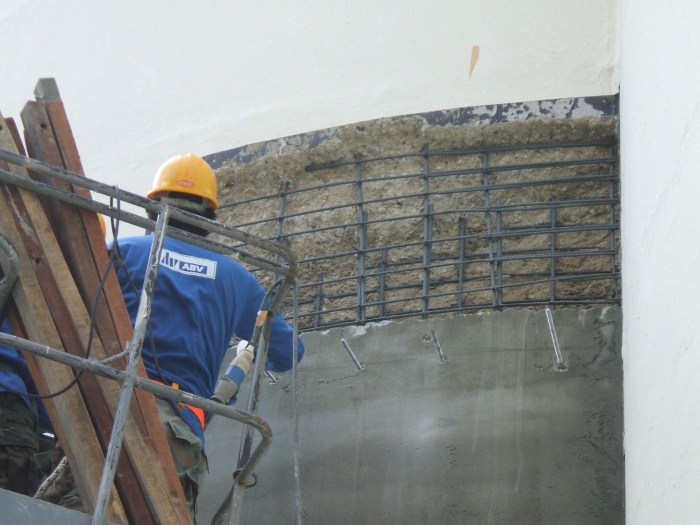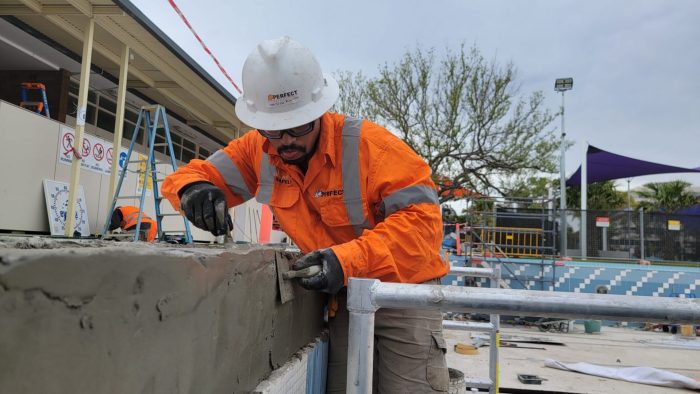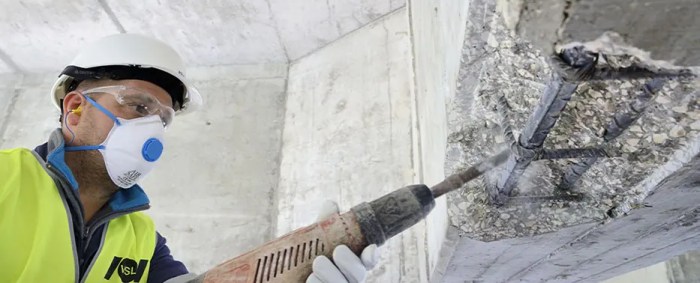Construction
Exploring the World of Structural Repair Contractors

Diving into the realm of structural repair contractors, this introduction sets the stage for a fascinating exploration of their role and significance in the construction industry. From handling various types of structural repairs to the crucial importance of hiring qualified professionals, this topic delves into a world where expertise meets necessity.
As we delve deeper, readers will gain insight into the skills, techniques, and safety measures employed by these contractors, shedding light on a vital aspect of the construction field that often goes unnoticed.
Overview of Structural Repair Contractors
Structural repair contractors play a crucial role in the construction industry by addressing and fixing various structural issues in buildings and infrastructure. These professionals are trained to assess, repair, and reinforce structures to ensure safety and stability.
Types of Structural Repairs
- Foundation Repair: Fixing cracks, settling, or shifting in the foundation of a building.
- Concrete Repair: Repairing and reinforcing concrete structures such as walls, columns, and beams.
- Roof Repair: Addressing leaks, sagging, or damage to the roof structure.
- Wall Repair: Fixing cracks, bulges, or deterioration in walls due to various factors.
- Structural Reinforcement: Strengthening existing structures to withstand additional loads or improve stability.
Importance of Hiring Qualified Structural Repair Contractors
It is essential to hire qualified structural repair contractors for several reasons:
- Expertise: Qualified contractors have the knowledge and skills to accurately assess and address structural issues.
- Safety: Ensuring that repairs are done correctly is crucial for the safety of occupants and the longevity of the structure.
- Compliance: Qualified contractors adhere to building codes and regulations, avoiding legal issues and ensuring quality work.
- Long-term Solutions: Professionals can provide long-lasting solutions that prevent recurring structural problems.
Skills and Qualifications
To excel as a structural repair contractor, individuals need a unique set of skills and qualifications that set them apart in the construction industry. Let's delve into the essential requirements for this field.
Essential Skills
- Strong knowledge of building materials and structures.
- Ability to read and interpret blueprints and technical drawings.
- Excellent problem-solving skills to identify and address structural issues effectively.
- Proficiency in using a variety of construction tools and equipment.
- Attention to detail to ensure precision in repair work.
- Good communication skills to interact with clients, team members, and other professionals.
- Physical stamina and strength to handle the physical demands of the job.
Qualifications and Certifications
While a high school diploma is the minimum educational requirement for becoming a structural repair contractor, gaining additional qualifications and certifications can enhance your credibility and expertise in the field. Some essential qualifications include:
- Associate's or bachelor's degree in construction management or a related field.
- Completion of an apprenticeship program to gain hands-on experience.
- Obtaining a contractor's license to work legally in the construction industry.
- Optional certifications such as Certified Construction Manager (CCM) or Certified Professional Constructor (CPC) to demonstrate expertise.
Specialized Training Programs
For those looking to specialize in structural repair work, various training programs are available to enhance skills and knowledge in this specific area. Some examples include:
- Structural Repair Technician Certification Program offered by the Structural Repair Association.
- Advanced Structural Repair Training Course focusing on advanced repair techniques and technologies.
- Specialized workshops and seminars on foundation repair, concrete restoration, and structural stabilization.
Common Structural Issues

Structural issues can arise in buildings for a variety of reasons, leading to the need for professional contractors to assess and repair the damage. Here, we will explore some of the most common structural problems, their causes, and how contractors go about diagnosing and fixing them.
Foundation Cracks
Foundation cracks are a common structural issue that can be caused by a variety of factors, such as poor construction, soil movement, or water damage. These cracks can lead to further damage if not addressed promptly, jeopardizing the stability of the entire structure.
Roof Leaks
Roof leaks are another common problem that can result in water damage, mold growth, and structural compromise if left untreated. Causes of roof leaks can include damaged shingles, improper installation, or aging materials. Contractors must assess the extent of the damage and identify the source of the leak to provide an effective repair solution.
Wall Bowing or Bulging
Wall bowing or bulging occurs when the walls of a building start to curve or protrude outward, indicating underlying structural issues. This can be caused by poor soil conditions, water pressure, or a weak foundation. Contractors use specialized tools and techniques to assess the severity of the problem and devise a repair plan.
Repair Techniques and Solutions

In the field of structural repair, contractors utilize a variety of techniques to address different issues that buildings may face. These techniques range from temporary solutions to permanent fixes, each serving a specific purpose depending on the severity of the problem at hand.
Different Repair Techniques
- Concrete Crack Injection: This method involves injecting a polyurethane or epoxy material into cracks in concrete structures to prevent further damage and restore structural integrity.
- Carbon Fiber Reinforcement: Carbon fiber sheets are used to reinforce and strengthen weak or damaged structural elements, such as beams or columns, providing increased load-bearing capacity.
- Underpinning: Underpinning is a process of strengthening the foundation of a building by extending it to a deeper, more stable soil layer, preventing settlement and structural damage.
Temporary Solutions vs. Permanent Fixes
Temporary solutions are often quick fixes to address immediate issues and prevent further damage, but they may not provide a long-term solution. On the other hand, permanent fixes involve more extensive repairs and structural reinforcement to ensure the longevity and stability of the building.
Importance of Quality Materials
Using high-quality materials in structural repairs is crucial to ensure the durability and effectiveness of the repair work. Inferior materials can lead to premature failure and compromise the safety of the structure, emphasizing the need for contractors to prioritize quality when selecting materials for repair projects.
Safety Measures
When it comes to structural repair contractors, safety is always a top priority. These professionals are trained to follow strict safety protocols to ensure the well-being of themselves and others on the repair site.It is crucial for structural repair contractors to wear appropriate safety gear and use the necessary equipment while working on repair sites.
This includes hard hats, safety glasses, gloves, steel-toed boots, and harnesses when working at heights.
Safety Protocols
- Before starting any repair work, contractors conduct a thorough inspection of the site to identify potential safety hazards.
- Contractors are required to follow OSHA guidelines and regulations to maintain a safe working environment.
- Communication is key on repair sites, with contractors constantly updating each other on their progress and any safety concerns.
Importance of Safety Gear
- Wearing safety gear protects contractors from injuries caused by falling debris, sharp objects, or hazardous materials.
- Proper safety gear also minimizes the risk of accidents and ensures a higher level of safety for everyone involved in the repair project.
Common Safety Hazards
- Working at heights without proper fall protection.
- Exposure to toxic materials such as asbestos or mold during repairs.
- Structural instability leading to collapses or accidents.
Cost Estimation and Budgeting

When it comes to structural repair projects, estimating costs accurately is crucial for both contractors and clients. A well-planned budget ensures that the repair work can be completed effectively without unexpected financial burdens.
Estimating Repair Costs
Estimating repair costs involves a detailed assessment of the structural issues present and the extent of damage. Contractors typically consider the following factors:
- The type of structural damage (foundation, walls, roof, etc.)
- The materials needed for repairs
- The labor costs involved
- Permits and inspection fees
Factors Influencing Budget
Several factors can influence the budget for structural repairs, including:
- The severity of the damage
- The size of the structure
- The accessibility of the damaged area
- The need for specialized equipment or expertise
Tips for Effective Budgeting
Clients can budget effectively for repair work by:
- Getting multiple quotes from different contractors for comparison
- Setting aside a contingency fund for unexpected expenses
- Communicating openly with the contractor about budget constraints
- Prioritizing repairs based on urgency to manage costs
Project Management
Structural repair contractors play a crucial role in managing projects from start to finish, ensuring that the repair work is completed efficiently and effectively. This involves coordinating with various stakeholders, overseeing the implementation of repair techniques, and adhering to safety measures throughout the process.
Importance of Timelines and Deadlines
Timelines and deadlines are essential in repair projects to ensure that the work is completed within a specified timeframe. Delays can lead to additional costs, inconvenience to clients, and potential safety hazards if structural issues are left unresolved for an extended period.
Successful Project Management Strategies
- Effective Communication: Maintaining clear and open communication with clients, subcontractors, and team members is crucial for successful project management.
- Resource Planning: Proper allocation of resources such as materials, equipment, and manpower is key to ensuring that the project progresses smoothly.
- Risk Management: Identifying potential risks and developing contingency plans to mitigate them can help prevent delays and disruptions during the project.
- Quality Control: Regular inspections and quality checks are essential to ensure that the repair work meets industry standards and client expectations.
Last Word
In conclusion, the discussion on structural repair contractors unveils a realm of challenges and solutions that shape the built environment we interact with daily. From project management strategies to cost estimation tips, this overview serves as a gateway to understanding the intricate world of structural repairs.
Question & Answer Hub
What are the common structural problems that require repair?
Common issues include foundation cracks, sagging floors, and water damage, among others.
What qualifications are needed to become a structural repair contractor?
Typically, contractors need relevant certifications, experience, and knowledge of construction techniques.
How do contractors assess structural problems?
Contractors use tools like infrared cameras and moisture meters to identify issues accurately.
-

 General6 months ago
General6 months agoSmall Home Renovation Ideas: 5 Creative Ways to Maximize Space
-

 General8 months ago
General8 months agoAI-powered lifestyle design tools for home planning: Revolutionizing Efficiency and Customization
-

 General8 months ago
General8 months agoCaptivating Title: Interior and Exterior Design Ideas for Wellness Retreats
-

 General6 months ago
General6 months agoCaptivating Fire Pit Patio Design Ideas to Transform Your Outdoor Space
-

 General6 months ago
General6 months agoThe Ultimate Guide to the Best Architectural Rendering Services for High-End Real Estate
-

 General7 months ago
General7 months agoEco-Friendly House Paint Options: A Guide to Sustainable Painting Choices
-

 General7 months ago
General7 months agoCrafting Energy Efficient Home Exteriors: A Guide to Sustainability
-

 General7 months ago
General7 months agoCrafting a Timeless Aura: Unveiling the Magic of Scandinavian Interior Design





